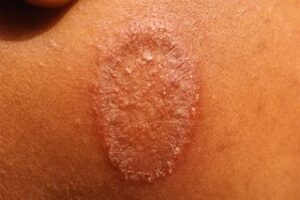Ringworm on darker skin tones may present with less noticeable redness and instead appear as brown or grayish patches with a raised, scaly border. The central area of the rash may be clear or scaly, and the condition can cause itching. While ringworm is often associated with a red ring-like appearance on lighter skin, the color variation is a key characteristic on black skin.

Symptoms on Darker Skin:
Instead of a red ring, ringworm on darker skin may appear as brown or gray patches.
A distinct, raised, and scaly border is a key feature, regardless of skin tone.
The center of the ring may be clear or scaly, with the surrounding area potentially having bumps or pustules.
Ringworm can be itchy, regardless of skin color.
Diagnosis and Treatment:
If you suspect ringworm, especially if it’s not responding to over-the-counter treatments, it’s crucial to see a dermatologist or healthcare professional for proper diagnosis and treatment.
Treatment typically involves antifungal creams or, in some cases, oral medications.
Keeping the affected area clean and dry, avoiding scratching, and using mild cleansers can aid in recovery.
Important Considerations:
Black individuals may be more susceptible to ringworm on the scalp, and proper hygiene is crucial in preventing its spread.
Because of the different appearance on darker skin, it’s important to be aware of the potential for misdiagnosis if ringworm is mistaken for other conditions like eczema or psoriasis.